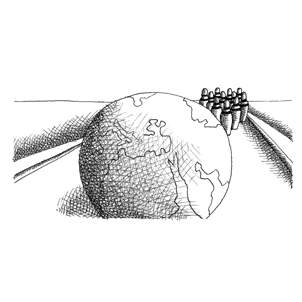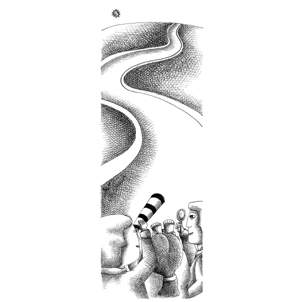In this chapter:

The Earth moves under our feet all the time. More than 200 million years ago our planet had only one supercontinent, Pangaea, which later broke up into several pieces that drifted apart, ultimately forming the continents we know today. The motion that broke up Pangaea continues to this day: tectonic plates, which fit together like a jigsaw puzzle to form the Earth’s crust, move at the rate of 1 to 25 centimeters per year. Most of the time this geological restlessness reshapes the surface of the planet gradually, without causing major catastrophes; but when parts of the Earth’s crust move suddenly, the resulting earthquakes may produce rapid changes and destroy entire cities. Weizmann Institute scientists conduct research aimed at understanding earthquakes and other geological disasters. Human activity can also alter the Earth’s physical features. For example, a dam may cause a river to change its course, or even its length. Some activities, such as logging, mining, and drilling, have destructive effects on the land. Institute scientists use their expertise to prevent destructive land management.
Earthquakes: Past and Future

In ancient China, a seismograph - a device used to study earth vibrations - was designed as a vessel with eight outward-facing dragons carved from jade, each holding a ball in its mouth. Following an earthquake, a priest would check which of the dragons had lost its ball into the open mouth of a frog beneath. This ingenious research installation focused on a simple parameter still used in earthquake studies: the direction of seismic wave propagation, which helps assess and interpret seismic damage. But modern earthquake researchers look to the ancient past for a different reason: information about past seismic events may help assess the risk of future earthquakes. Another approach to understanding and possibly one day predicting earthquakes is the scientific analysis of their dynamics, via field work and theoretical modeling.
Prof. Emanuel Mazor of the Institute’s Environmental Sciences and Energy Research Department, now retired, has collaborated with researchers from the Ramon Science Center to examine evidence of earthquakes in several ancient cities in the Negev during the Nabatean, Roman, and Byzantine periods. The researchers focused originally on the city of Avdat, situated on the so-called Spice Road, a caravan route that served to transport spices, incense, and jewels from the Orient and the Arabian peninsula to the Mediterranean. They discovered that the city had been demolished by earthquakes not once, as previously thought, but twice: during the 4th and 7th centuries. By studying the destruction patterns on the site, such as the direction in which building walls had collapsed, the researchers were able to assess the magnitude and locate the epicenter of those earthquakes. At least some of the ancient settlements surrounding Avdat may also have been destroyed by earthquakes. The scientists concluded that strong earthquakes hit the central Negev every few hundred years, and that all plans for urban and industrial development in the Negev must take into consideration the seismic hazard. On a broader scale, this research has provided the foundation for the evolving scientific branch of applied archeoseismology, the study of ancient earthquakes based on archeological evidence.
Dr. Einat Aharonov, another member of the Environmental Sciences and Energy Research Department, conducts research that may improve the understanding of earthquakes and perhaps eventually lead to their prediction. Combining field and experimental data with computer and mathematical models, Aharonov studies how slabs of rock slide past one another during an earthquake. One of her projects focuses on the modeling of granular materials, such as sand grains collected in a bucket. Lack of fundamental knowledge about the complex behavior of granular materials hampers the understanding of many earth systems, including earthquakes, landslides, and soil erosion. As part of these studies, Aharonov and her colleagues are using a computer model to simulate events taking place in the “fault gouge,” the crushed-up granular region in the area of friction between tectonic plates, where earthquakes originate. In other projects, Aharonov is studying the formation of sedimentary rock and the effects of flowing fluids, such as lava or water, on geological structures within the Earth’s crust and mantle.
National Heritage
The colorful, rocky Negev desert - comprising about half of Israel’s land but inhabited by only 8 percent of its population - offers unique opportunities for recreation and research: it is the only part of Israel where vast expanses of land are still untouched by construction and development. Among the desert’s more spectacular sites are the makhtesh valleys - bowl-shaped land formations surrounded by steep cliffs and drained by a single narrow riverbed. There are five such formations in the Negev, the largest of which is the 25-mile-long Makhtesh Ramon. Providing unimpeded access to objects that can elsewhere be approached only through digging, Ramon is a geologist’s paradise; its layered walls, dating back more than 200 million years, display a breathtaking array of rocks, fossils, and magma. For tourists, the makhtesh offers hiking trails and spectacular views from the top.
The Ramon National Geological Park, today a national and international tourist attraction, was created in the 1980s on the basis of a master plan drawn up by the Weizmann Institute’s Prof. Emanuel Mazor. The plan was designed to save the makhtesh from destruction by mining for sand and clay, and turn it into a nature laboratory. In 1990 Mazor participated in the establishment of the Ramon Science Center, which today serves as a basis for multidisciplinary research on the geology, hydrology, botany, and zoology of the area. One of the Center’s major research projects, conducted with Weizmann Institute scientists and with geophysicists from the former Soviet Union, has focused on the earthquakes that destroyed the Negev’s ancient cities centuries ago.
Prof. Mazor has developed a concept that makes it possible to combine the preservation of naturewith industrial and urban development. His idea is to turn parts of the Negev into environmental nature reserves: not regular national parks where all construction and activity other than hiking is prohibited, but areas in which a “core” of protected landscapes is surrounded by a limited number of settlements designed in a way that prevents environmental destruction. Mazor has also designed long-term strategies aimed at increasing public awareness and generating support for the protection of the environment. A variety of educational programs and guided tours initiated by him in Makhteshim Country - the part of the central Negev containing all five makhtesh valleys - offer the public a chance to develop a deeper appreciation of this unusual geological habitat. In special resolutions of 1996 and 1998, Makhteshim Country was declared a protected area by the Israel government.
The makhteshim are superbly preserved ecological systems, perfectly suited to the study of desert animals and plants: due to restricted access and a lack of arable land and water springs, ancient humans never settled and did not engage in agriculture inside the makhteshim. On the other hand, adjacent parts of the central Negev, particularly the river beds, offer ample material for the study of ancient agriculture, which began some 3,000 years ago and reached its peak around 1,300 years ago. Well-preserved remains reveal that ancient farmers engaged in “sustainable” agricultural activity in the Negev desert for centuries: they built terraces to facilitate land cultivation, stabilized loess (loamy deposits suitable for planting crops), and harvested runoff water from the hill slopes. Prof. Mazor has compiled research findings on ancient agriculture in Makhteshim Country, arguing that they can yield useful clues for modern land management, particularly in light of concern about the destruction of fertile land by harmful farming practices in different parts of the world. Mazor was also instrumental in nominating Makhteshim Country as a candidate for recognition as one of UNESCO’s World Nature and Heritage sites.
Shaping Israel’s Future

An unprecedented effort to shape Israel’s future was launched in the 1990s: some 250 experts in areas covering various aspects of the country’s economy, as well as such vital issues as security and education, were asked by several government ministries to draw up a plan for Israel’s development in the 21st century and, more specifically, in the century’s first two decades. Their recommendations were summed up in 18 volumes that appeared in 1997 under the title “Israel 2020.” The Planning Authority of Israel’s Ministry of the Interior went on to translate these recommendations into a concrete plan of action called Master Plan 35. The plan charts a comprehensive course for Israel’s development in the first century of the new millennium.
Prof. Emanuel Mazor took an active part in the preparation of “Israel 2020” and has continued to contribute feedback and counseling to the drafting of Master Plan 35. Mazor’s contribution lies in promoting the concept of “environmental planning”: adoption of planning principles that preclude destruction of the environment. He has defined a general approach, which stipulates that preservation of the environment must be taken into account whenever the economic feasibility of a development scheme is being assessed. In addition, he has drawn up specific recommendations for development in different settings - including beaches, rivers, mountains, highways, settlements, and nature reserves.






















